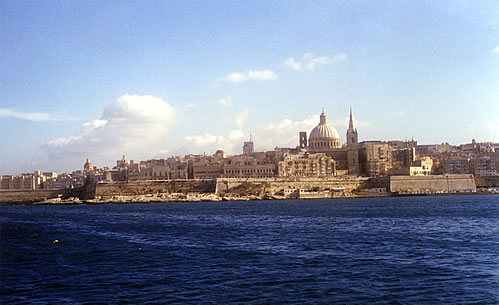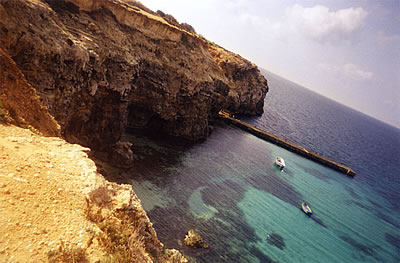|
Crossroads of the Mediterranean
Study Abroad in Malta
Article and photos by Brian Liesinger

|
|
A view of the capital city of Valletta, Malta, from across the harbor. |
“Malta? Where is that?”
I had grown tired of answering the question shortly after returning from my semester in the country. But the question still arises, and I do my best to answer considerately and politely. I tell people it is an island nation about 60 miles south of Sicily — in the middle of the Mediterranean Sea. Yes, it is a small country, with just over 530,000 people living on about 120 square miles. But what it lacks in population and landmass, it more than makes up for in history, culture, and beauty.
From there, I am tempted to brag about Malta’s 7,000 years of occupied history, temples that are older than the pyramids and Stonehenge, the country’s bold stance against the Axis powers in WWII, Caravaggio’s stint there, the baroque architecture, the North African and Italian influences that have shaped the culture, and, of course, the breath-taking seascapes. Instead, I usually bite my tongue — for fear that this jewel of the Mediterranean will become overrun by American tourists. But now, as a graduate student and an employee of a study abroad office, I am willing to rattle on about it to any student who will listen.
Malta was an excellent choice for me as an undergraduate because I had never been abroad before. I was fascinated with their Arabic-based language, though relieved that English is also an official language and all courses at the University of Malta are taught in English. It is also an interesting place to study journalism, given its location and the influences of North Africa and Western Europe. My international journalism courses at the University of Malta were incredibly challenging and rewarding. I also took culture and history courses and signed on for a service-learning experience that changed my life in ways I could not have imagined before I arrived.
A Brief History of Malta
Malta's location in the Mediterranean Sea has made it a convenient crossroads for conquerors since the Phoenicians arrived around 800 BC. The Romans eventually absorbed Malta as part of their empire, beginning a chain of conquests that included Arabs from North Africa, Sicilians, the Napolean-led French, and the British. Malta achieved its independence in 1964 and joined the European Union in 2004.
The University Of Malta
The University of Malta is a top-notch European educational institution. In general, instructors there expect more out of students than their American counterparts. Syllabi aren’t structured to walk you through every minute of course time in a semester. You are expected to cover the reading list independently and come to class prepared to participate. Exams are a rarity, especially in the arts and humanities courses. Final papers and projects are often assigned early in the semester for these areas. Due to the country's immigration and refugee issues, it is an exciting place to study refugee and asylum law, human rights, and public policy.
The student population is diverse, so meeting other international students is easy, especially if you live in the University Residences. Make an effort to engage Maltese students as well. The Maltese are generally more reserved, but once you gain their trust, you will find that they are incredibly friendly and honest.
While my program was organized by Luther College, a small liberal arts school, enrolling directly at the University of Malta as an international student is possible. The University's course offerings also match those offered on most U.S. campuses. In addition, International Student Exchange Programs (ISEP) offers an exchange program to the University of Malta.
Considering Costs in Malta
One of the best things about studying in Malta now is its affordability relative to the U.S. Depending on what you pay for tuition at your home institution, the University of Malta may cost considerably less. Academic year tuition for international students ranges from about €11,000, which is a great value for the quality of the education. Living expenses are roughly €15,000 per semester, including lodging options. By living in a flat, I could integrate into a neighborhood. There was a local store, a pub to frequent, a gym that offered discount memberships to students, and friendly neighbors to socialize with. Plus, sharing a 3- or 4-bedroom apartment can save you considerable cash on accommodations if you can locate a few roommates.
Public transit on the island is incredibly affordable, and due to the small size of the island, your longest ride would be about an hour. Basic bus fares are less than a dollar. One, three, five, and seven-day passes are also available. The buses are a great way to explore the island and a cultural icon of Malta. Pay a flat fee and ride around all day, taking in the landscape and chatting with the Maltese. However, remember that the public transit system, while fairly extensive, is not always the most consistent, especially on the island of Gozo. Study schedules carefully and ask the drivers questions. An alternative to the buses in Valletta and the surrounding area is eco-friendly electric mini cabs. These electric vehicles roam around the perimeter of the capital city and can be hailed like any taxi. The fare cost cannot exceed €5 per person.
With Italian, Spanish, Moorish, and even British influences, Maltese cuisine is diverse and delectable. However, it can also be expensive in higher-end restaurants. To save on meals, avoid regular splurges and stick with the local standards: ftira bread filled with whatever is in season. Pastries called pastizzi, often filled with ricotta and peas, are also a local favorite that is widely available, delicious, and cheap. For affordable prices, you will find these and many other baked goods at bakeries all over the islands. The climate also allows for a long growing season, so take advantage of fruits and vegetables. Farmers load up their trucks and set up curbside stands to sell their produce for a fraction of what the supermarkets charge.
Travel in Malta

|
|
The jagged Maltese coastline.
|
Despite seeming isolated, traveling to mainland Europe from Malta is relatively inexpensive. Catch a high-speed ferry to Sicily and choose trains or planes from there. The cheap, adventurous train route from Sicily to Rome is well worth it if you have the time. You can catch affordable airfare from Rome to other European destinations or continue your train ride north. Do not overlook Malta, however. This archipelago is packed with fascinating sites. Trust me: seeing them all takes more than an entire semester.
Brian Liesinger lives in Minneapolis, MN, and focuses his graduate coursework on cultural studies and creative nonfiction. He constantly considers how these interests will lead to his next experience abroad.
|
